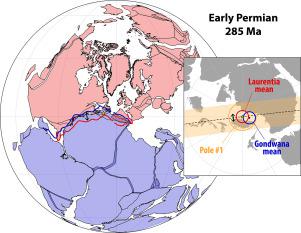当前位置:
X-MOL 学术
›
Gondwana Res.
›
论文详情
Our official English website, www.x-mol.net, welcomes your
feedback! (Note: you will need to create a separate account there.)
On the Early Permian shape of Pangea from paleomagnetism at its core
Gondwana Research ( IF 7.2 ) Pub Date : 2021-02-01 , DOI: 10.1016/j.gr.2020.11.005 Mathew Domeier , Eric Font , Nasrrddine Youbi , Joshua Davies , Samantha Nemkin , Rob Van der Voo , Morgann Perrot , Mohamed Benabbou , Moulay Ahmed Boumehdi , Trond H. Torsvik
Gondwana Research ( IF 7.2 ) Pub Date : 2021-02-01 , DOI: 10.1016/j.gr.2020.11.005 Mathew Domeier , Eric Font , Nasrrddine Youbi , Joshua Davies , Samantha Nemkin , Rob Van der Voo , Morgann Perrot , Mohamed Benabbou , Moulay Ahmed Boumehdi , Trond H. Torsvik

|
Abstract Although central to an understanding of Earth's paleogeography and the myriad processes that it affects, the geometry of Pangea during the early phase of its lifetime has remained a topic of contention since the plate tectonic revolution. Despite decades of analysis and discussion, the crux of this debate still largely hinges on sparse, legacy paleomagnetic data derived from early Permian rocks of the Moroccan Meseta. In this work, we present the results of a study designed to revisit, update and expand on those key data, with the provision of new geochronologic and paleomagnetic results from six Permo-Carboniferous basins in central Morocco. New U-Pb zircon ages from volcanic rocks substantiate and refine existing geochronological data and reveal that volcanism among the studied basins spanned approximately 30 Ma, from at least 305 to 277 Ma, but was possibly punctuated by a more intense pulse in the mid-early Permian (~285 Ma). These new U-Pb data furthermore suggest that the age estimates previously assigned to the key poles from the Moroccan Meseta are probably too young, by some ~10 Ma. New paleomagnetic results from six basins yielded a common, well-defined remanent magnetization from 20 sites that is demonstrated to be pre-middle Permian in age. However, it remains unclear whether this magnetization (which is directionally similar to the previous paleomagnetic data from the same basins) is a primary magnetization acquired at ~285 Ma, or a syn-folding remagnetization that was acquired shortly thereafter, at ~275 Ma. In adopting both interpretations as alternative hypotheses, we examine the corresponding paleogeographic implications of both. Through exhaustive comparisons with reference apparent polar wander paths and the direct reconstruction of Gondwana using these new paleomagnetic results, we demonstrate that in either case (i.e. whether the remanent magnetization is primary or was acquired soon after during folding) the data is compatible with a Pangea A geometry during the early Permian. We close with a topical discussion of some persisting arguments used to defend Pangea B and why we consider them to be flawed.
中文翻译:

从古地磁学看盘古早二叠世地核形态
摘要 尽管对于了解地球古地理及其影响的无数过程至关重要,但自板块构造革命以来,盘古大陆早期的几何形状一直是争论的话题。尽管进行了数十年的分析和讨论,但这场争论的症结仍然主要取决于源自摩洛哥梅塞塔早期二叠纪岩石的稀疏的遗留古地磁数据。在这项工作中,我们展示了一项旨在重新审视、更新和扩展这些关键数据的研究结果,并提供了来自摩洛哥中部六个二叠纪-石炭纪盆地的新的地质年代学和古地磁结果。来自火山岩的新 U-Pb 锆石年龄证实和完善了现有的地质年代学数据,并揭示了研究盆地之间的火山活动跨越了大约 30 Ma,从至少 305 到 277 Ma,但可能被二叠纪中早期(~285 Ma)更强烈的脉冲所打断。这些新的 U-Pb 数据进一步表明,先前分配给来自摩洛哥梅塞塔的关键极点的年龄估计可能太年轻了,大约为 10 Ma。来自六个盆地的新古地磁结果在 20 个地点产生了共同的、明确定义的剩余磁化,证明其年龄为中二叠纪前。然而,目前尚不清楚这种磁化强度(与之前来自同一盆地的古地磁数据在方向上相似)是在~285 Ma 处获得的初级磁化强度,还是之后不久在~275 Ma 处获得的同步折叠再磁化。在采用这两种解释作为替代假设时,我们检查了两者相应的古地理含义。通过与参考表观极地漂移路径的详尽比较以及使用这些新的古地磁结果直接重建冈瓦纳大陆,我们证明在任何一种情况下(即剩余磁化是初级还是在折叠后不久获得)数据与盘古大陆兼容二叠纪早期的几何学。我们以对用于捍卫 Pangea B 的一些持久论据以及为什么我们认为它们有缺陷的专题讨论结束。
更新日期:2021-02-01
中文翻译:

从古地磁学看盘古早二叠世地核形态
摘要 尽管对于了解地球古地理及其影响的无数过程至关重要,但自板块构造革命以来,盘古大陆早期的几何形状一直是争论的话题。尽管进行了数十年的分析和讨论,但这场争论的症结仍然主要取决于源自摩洛哥梅塞塔早期二叠纪岩石的稀疏的遗留古地磁数据。在这项工作中,我们展示了一项旨在重新审视、更新和扩展这些关键数据的研究结果,并提供了来自摩洛哥中部六个二叠纪-石炭纪盆地的新的地质年代学和古地磁结果。来自火山岩的新 U-Pb 锆石年龄证实和完善了现有的地质年代学数据,并揭示了研究盆地之间的火山活动跨越了大约 30 Ma,从至少 305 到 277 Ma,但可能被二叠纪中早期(~285 Ma)更强烈的脉冲所打断。这些新的 U-Pb 数据进一步表明,先前分配给来自摩洛哥梅塞塔的关键极点的年龄估计可能太年轻了,大约为 10 Ma。来自六个盆地的新古地磁结果在 20 个地点产生了共同的、明确定义的剩余磁化,证明其年龄为中二叠纪前。然而,目前尚不清楚这种磁化强度(与之前来自同一盆地的古地磁数据在方向上相似)是在~285 Ma 处获得的初级磁化强度,还是之后不久在~275 Ma 处获得的同步折叠再磁化。在采用这两种解释作为替代假设时,我们检查了两者相应的古地理含义。通过与参考表观极地漂移路径的详尽比较以及使用这些新的古地磁结果直接重建冈瓦纳大陆,我们证明在任何一种情况下(即剩余磁化是初级还是在折叠后不久获得)数据与盘古大陆兼容二叠纪早期的几何学。我们以对用于捍卫 Pangea B 的一些持久论据以及为什么我们认为它们有缺陷的专题讨论结束。











































 京公网安备 11010802027423号
京公网安备 11010802027423号